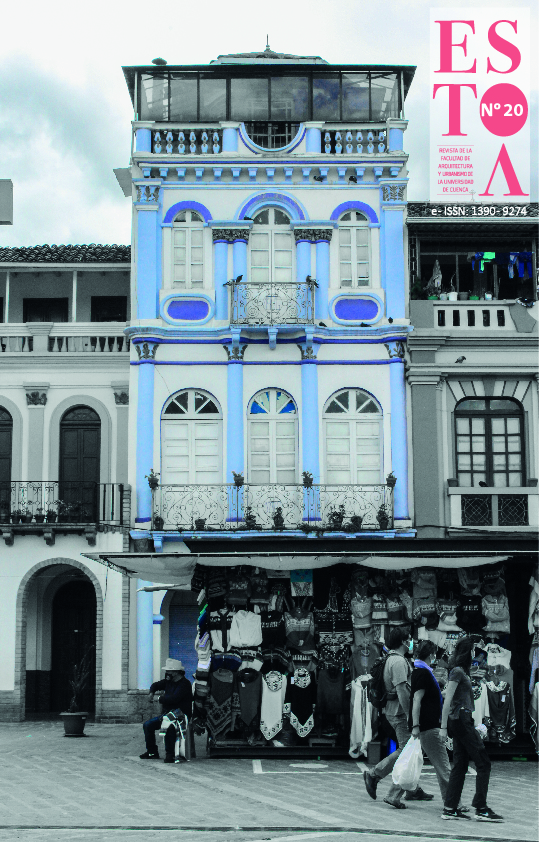Loja Urban Green System as the structuring base of the city
DOI:
https://doi.org/10.18537/est.v010.n020.a05Keywords:
green infrastructure, green system, biodiversity, sustainable city, LojaAbstract
Green infrastructure constitutes a new way of planning and managing the territory as a network of natural and semi-natural spaces that offer various ecosystem services; taking special importance in the urban environment for its contribution to the improvement of the quality of life, the conservation of biodiversity and the link with the rural context. This research addresses the identification and structure of the system’s elements in a city surrounded by a natural potential, through the introduction to its meaning, the systemic understanding of its elements in the case of the basin of Loja for its analysis and configuration, with a vision of guiding its management and conception. Thus, the urban green system of Loja tries to become the support of a sustainable city that contributes to creating a better place to live in relation to nature.
Downloads
References
Alcaldía de Medellín. (26 de mayo de 2021). Descripciones de proyectos Secretaría de Infraestructura. https://www. medellin.gov.co/irj/portal/medellin?NavigationTarget=c ontenido/5744-Descripciones-de-proyectos-Secretariade-Infraestructura
Allen, J. y Balfour, R. (2014). Natural solutions for tackling health inequalities. UCL Institute of Health Equity. https://www.instituteofhealthequity.org/resourcesreports/naturalsolutions-to-tackling-health-inequalities/ naturalsolutions-to-tackling-health-inequalities.pdf
Benedict, M. y McMahon, E. (2006). Green Infrastructure: Linking Landscapes and Communities. Island Press.
Borja, J. (2012). Espacio público y derecho a la ciudad. En Debats en Treball Social i Política Social. Universitat de Girona. https://debatstreballsocial.files.wordpress. com/2013/03/espacio_publico_derecho_ciudad_ jordiborja.pdf
Centro de Estudios Ambientales. (2016). La Infraestructura Verde Urbana de Vitoria-Gasteiz. Barrio a Barrio. CEA. Ayuntamiento de Vitoria-Gasteiz. https://www.vitoriagasteiz.org/docs/wb021/contenidosEstaticos/adjuntos/ en/47/38/64738.pdf
CINFA y Herbario Loja. (2006). Estado de conservación de áreas protegidas y bosques protectores de Loja y Zamora Chinchipe y perspectivas de intervención. Universidad Nacional de Loja. https://www.portalces.org/sites/ default/files/informeareaslojazamora.pdf
Constitución de la República del Ecuador [Const]. Art. 23, 31, 71. 20 de octubre de 2008 (Ecuador).
Davies, C., MacFarlane, R., McGloin, C. y Roe, M. (2015). Green infrastructure planning guide. Journal of Arboriculture, (30), 269-275.
De Vries, S. (2010). Nearby nature and human health: looking at mechanisms and their implications. En C. Ward, P. Aspinall y S. Bell (Eds), Innovative Approaches to Researching Landscape and Health. Open Space: People Space 2. Routledge.
European Environment Agency – EEA. (2011). Green infrastructure and territorial cohesion. The concept of green infrastructure and its integration into policies using monitoring systems. EEA.
Fadigas, L. (2009). La estructura verde en el proceso de planificación urbana. Ciudades, (12), 33-47.
Hábitat III. (2017). Nueva Agenda Urbana. Naciones Unidas. https://uploads.habitat3.org/hb3/NUA-Spanish. pdf
Hansen, R. y Pauleit, S. (2014). From Multifunctionality to Multiple Ecosystem Services? A Conceptual Framework for Multifunctionality. Green Infrastructure Planning for Urban Areas. AMBIO, (43), 516–529. https://doi. org/10.1007/s13280-014-0510-2
Hartig T., Mitchell, R., De Vries, S. y Frumkin, H. (2014). Nature and Health. Annual Review of Public Health, 35, 207-228. https://doi.org/10.1146/annurevpublhealth-032013-182443
Hu, T., Chang, J. y Syrbe, R. (2020). Green Infrastructure Planning in Germany and China. A comparative approach to green space policy and planning structure. Inclusive Urbanism: Advances in research, education and practice, 6, 99-126. https://doi.org/10.7480/rius.6.96
INEC (2010). Censo Nacional de Población y Vivienda. Gobierno de la República del Ecuador. https://www. ecuadorencifras.gob.ec/base-de-datos-censo-depoblacion-y-vivienda-2010-a-nivel-de-manzana/
Landscape Institute. (2009). Green infrastructure: connected and multifunctional landscapes. Landscape Institute Position Statement.
Matthews, T., Lo, A. y Byrne, J. (2015). Reconceptualizing green infrastructure for climate change adaptation: Barriers to adoption and drivers for uptake by spatial planners. Landscape and Urban Planning, 138, 155-163. https://doi.org/10.1016/j.landurbplan.2015.02.010
Municipio de Loja, UTPL y GIZ. (2020a). Laboratorio Urbano de Loja 2019. Integrar la naturaleza. Universidad Técnica Particular de Loja.
Municipio de Loja, UTPL y GIZ. (2020b). Plan del Sistema Verde Urbano de Loja. Universidad Técnica Particular de Loja.
Naciones Unidas. (2021). Objetivo 11: Lograr que las ciudades sean más inclusivas, seguras, resilientes y sostenibles. Objetivos de Desarrollo Sostenible. ONU. https://www.un.org/sustainabledevelopment/es/cities/
Sahagún, F., Aceves, J., Sánchez, E. y Plazola, L. (2020). Valoración de los servicios ecosistémicos en áreas verdes. El caso del Parque Metropolitano de Guadalajara, México. Acta universitaria, 30, e2635. https://doi. org/10.15174/au.2020.2635
Silva, C., Viegas, I., Panagopoulos, T. y Bell, S. (2018). Environmental Justice in Accessibility to Green Infrastructure in Two European Cities. Land, 7(4), 134. https://doi.org/10.3390/land7040134
Valdés, P. y Foulkes, M. (2016). La infraestructura verde y su papel en el desarrollo regional. Aplicación de los ejes recreativos y culturales de Resistencia y área metropolitana. Cuaderno Urbano. Espacio, cultura, sociedad, 20(20), 45-70.
Vásquez, A. (2016). Infraestructura verde, servicios ecosistémicos y sus aportes para enfrentar el cambio climático en ciudades: el caso del corredor ribereño del río Mapocho en Santiago de Chile. Revista de Geografía Norte Grande, 63, 63-86. http://dx.doi.org/10.4067/ S0718-34022016000100005
Published
How to Cite
Issue
Section
License
Copyright (c) 2021 Estoa. Revista de la Facultad de Arquitectura y Urbanismo

This work is licensed under a Creative Commons Attribution-NonCommercial-ShareAlike 4.0 International License.
The Journal declines any responsibility for possible conflicts derived from the authorship of the works that are published in it.
The University of Cuenca in Ecuador conserves the patrimonial rights (copyright) of the published works and will favor the reuse of the same ones, these can be: copy, use, diffuse, transmit and expose publicly.
Unless otherwise indicated, all contents of the electronic edition are distributed under a Creative Commons Attribution-NonCommercial-ShareAlike 4.0 International License.




